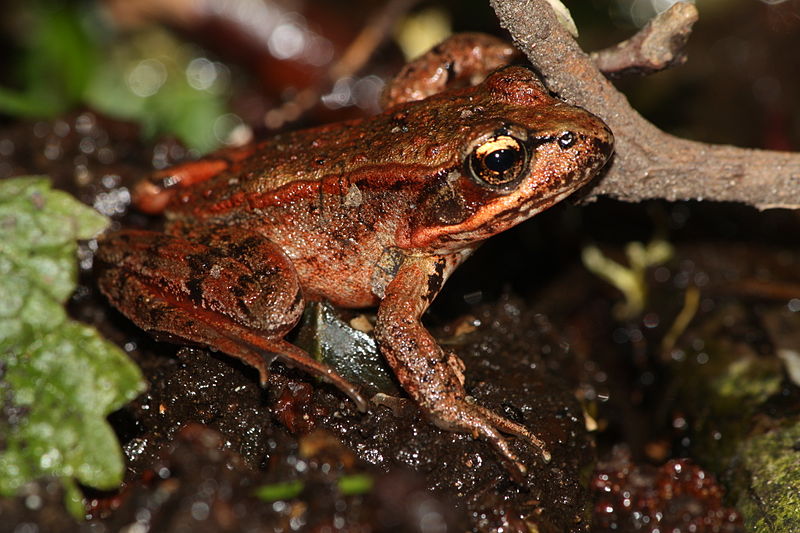Red-legged frogs have returned to Southern California for the first time in nearly 20 years. The species, which disappeared from San Diego County in 1974, was decimated by disease and invasive species but is now making a comeback thanks to the efforts of a multinational group of conservationists including San Diego State alumna Anny Peralta Garcia.
The effort involved translocating (moving them from location to another) eggs from Mexico, where the species only survived in one national park and a few ranches, to two sites in California where habitat restoration efforts had been successful.
Gathering eggs from Mexico proved to be a challenge, however, as the population has been greatly diminished there as well. Peralta Garcia, who got her doctorate studying the status of red-legged frogs in Baja California, found the frogs in only 10 locations in Mexico.
“My husband and I started a non-profit to try and do something for the species because we knew it was in bad shape,” said Peralta Garcia. “We find them only in 10 sites and with really low numbers. When we went to survey red-legged frogs we usually only found between five and 10 individuals. So, it was really bad, except for one locality where they were abundant.”
Peralta Garcia began working on restoring the populations in Mexico to a more sustainable level so that one day they could be reintroduced into the Southern California ecosystem.
“The first thing we did, since the populations were really small, we wanted to increase the numbers,” said Peralta Garcia. “What people have been doing in California is pond building. So, they need ponds to reproduce and lay their eggs. A lot of that habitat was lost in Baja California because of water extraction and agriculture, and you know, the usual.”
As Peralta Garcia and her team were working on restoring habitats and population in Mexico, work on building sustainable habitats in Southern California was being spearheaded by Clark Winchell from the U.S. Fish and Wildlife Service. Winchell and his team found two sites that could be restored to bring the frogs back to the United States.
“By chance, we had a meeting at the San Diego Natural History Museum; they had been collaborating with us since the start,” said Peralta Garcia. “We had a meeting on bullfrogs, actually, because we also do bullfrog eradication in Baja California. At that meeting, we met Clark Winchell from the U.S. Fish and Wildlife Service and he has been working on a site in California trying to restore the habitat and reintroduce pond turtles. That was also a good size for red-legged frogs, and he said, ‘Hey I have been thinking about reintroducing red-legged frogs, and I hear that you are working with the red-legged frogs in Baja so why don’t we reintroduce them!’”
The next step involved translocating egg masses (red-legged frogs lay their eggs in communal nesting locations known as egg masses) across the border from the habitats in Baja California into the restored ponds in Southern California. The effort to transport the half egg masses, which can total 300 to 500 eggs, to each site began in February and March 2020.
Additional challenges arose as the coronavirus pandemic began around the same time that Peralta Garcia and her collaborators were trying to get the eggs across the border.
“Last year was the first time we did it so there was a lot of permitting, think about all the permits in California and in Mexico, and also you have COVID in the middle,” said Peralta Garcia. “We had other plans of flying them directly from the site, from donor sites to all the way to where they were gonna be released but that couldn’t happen for several reasons including COVID.”
The half-masses of eggs made it across the border to the two sites that Winchell had restored for the frogs and pond turtles.
“We did translocation for three half-masses, so we only take half of the egg masses and we reintroduced to two sites, one site got two the other one got one,” said Peralta Garcia. “The one with the two sites, we didn’t have a lot of survivalship. We are still trying to figure out what happened there.”
The site that received one half-mass of eggs had a much higher survival rate according to Peralta Garcia with around 400 tadpoles surviving. In December 2020 around 60 juveniles were spotted by the team monitoring the pond.
It takes around two years for the frogs to mature from egg to adult and the survival rate for the red-legged frogs is around 3%, with only about 9-15 frogs surviving until adulthood. Peralta Garcia said she and her team hope to have the frogs be self-sufficient within 5-7 years.
“The project is to have translocations for three years and we just did translocation also this year,” said Peralta Garcia. “We hope to do it at least three times so that will give them enough numbers and genetic diversity for that population. We hope to see breeding in the fifth year, so that will be considered successful if that happens and at that point, we won’t be considering doing anymore reintroduction. The cause is for those sites to become a source to other sites in California for population reintroduction.”
More information about the reintroduction effort can be found here.







